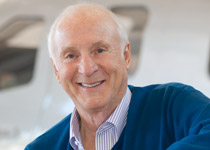GENERAL
- Why does moving the center of gravity forward make an airplane more stable in pitch and yaw?
- From reader Michael Dolin: The North American XB-70 Valkyrie supersonic bomber’s six engines were clustered in a single horizontal row beneath the aircraft. This was colloquially known as a six-pack (of engines). With what six-pack (having nothing to do with engines) are most general aviation airplanes equipped?
- A pilot is preflighting a Cessna 172 in the vicinity of thunderstorm activity when his skin suddenly begins to tingle and his hair stands straight up ( à la boxing promoter Don King). What should he do?
- What was probably the most unconventional means by which a fighter pilot attacked and downed an enemy aircraft?
- I was a car dealer when I bought a Blériot monoplane in 1911 and taught myself to fly (crashing several times in the process). I became an airshow pilot and joined two other gentlemen to begin an airplane company in 1925. But I wanted to build monoplanes, and they preferred biplanes, so I formed my own company in 1927. Two of my airplanes were the DC–6 and DC–6B. My name is _______________.
- Excluding supersonic transports, what was the fastest jetliner ever produced?
- What is the most commonly accepted method used to clear a flooded engine?
MULTIPLE CHOICE
- The greatest number of engines ever used to power a production airplane was
- eight.
- 10.
- 12.
- 14.
- A pilot is on a nonstop flight from Los Angeles to Honolulu at FL180 (altimeter set to 29.92 inches Hg) and does not apply any wind correction (crab) whatsoever. The altitude of that flight level above both the departure and destination airports is 18,500 feet msl. Irrespective of whatever variable winds might be encountered en route, the aircraft will pass _______ Honolulu.
- directly over
- south of
- north of
- Insufficient information is provided.
- While listening to an air traffic control frequency, you overhear a pilot identifying himself as "Tango-Bonanza-Four-Six-Four-Alpha." The use of tango indicates that the aircraft
- has a turbine engine.
- has two engines.
- is an air-taxi flight.
- is turbocharged.
TRUE OR FALSE
- All tower-controlled civil airports are in Class B, C, or D airspace (when the control tower is open).
- FAA’s Operation Lights On encourages pilots to turn on their landing lights to enhance the see-and-avoid concept of collision avoidance when operating near an airport. With respect to extending the longevity of light bulbs, it is better to leave the lights on for the entire flight than to turn them on and off at the beginning and end of a flight.
- A woman, Hanna Reitsch, was the first to fly a jet-powered airplane.
ANSWERS
- Moving the CG forward increases the moment arm (leverage) of the horizontal and vertical stabilizers, which makes them more effective. An aft CG reduces pitch and yaw stability.
- The standard matrix of six flight instruments is similarly called a six-pack. These instruments consist of the airspeed indicator, attitude indicator, and altimeter (left to right, top row); and the turn-and-bank indicator (or turn coordinator), heading indicator, and VSI (left to right, bottom row).
- Lightning is headed his way. The pilot has a second or two to immediately drop to the ground in a ball and make as small a target of himself as possible so that that the bolt will hopefully strike something taller (such as the aircraft itself).
- Russian World War I ace Staff Capt. Alexander Kazabov trailed a grappling hook on a long rope and used it to attack and destroy German aircraft.
- Clyde Cessna (and not Donald Douglas) had two partners in the Travel Air Manufacturing Company, Walter Beech and Lloyd Stearman. The DC–6 (D for design, C for Cessna, and 6 for sixth design) was a four-place, high-wing, closed-cabin monoplane that debuted in 1929.
- The Convair 990 Coronado had a maximum cruise speed of 990 kph (535 knots or 615 mph), which is how the aircraft got its numerical designation.
- Crank the engine with the throttle fully open, the mixture control in idle-cutoff, and the fuel pump off (if installed) until the engine fires. Then increase the mixture and reduce power. (Consult the pilot’s operating handbook, however, for type-specific instructions.)
- (c) The 1929 German Dornier Do X flying boat was powered by 12 Curtiss Conqueror engines mounted in six pairs along the top of the wing. Each pair consisted of a tractor and a pusher mounted fore and aft in a single nacelle.
- (a) Whenever flying along a pressure surface (such as FL180) between two points that have the same altitude (msl), the net drift encountered will be nil irrespective of how much the winds change en route. This is a basic principle of pressure-pattern navigation (single-heading flight).
- (c) According to the Aeronautical Information Manual, the prefix tango is used by air taxi or other commercial operators that do not have FAA-authorized call signs.
- False. There are a number of such airports, including Kissimmee Municipal, Lake City Municipal, and Witham Field in Florida alone.
- True. According to General Electric, cycling light bulbs on and off is much more destructive than leaving them on (unless prohibited by the pilot’s operating handbook). Leaving the lights on for the entire flight offers the added advantage of enhancing safety during cruise.
- False. The petite German pilot, however, was first to fly the world’s first rocket-powered airplane, the Messerschmitt 163. She also flight tested a mammoth glider capable of carrying 200 soldiers and a tank.

Barry Schiff
Barry Schiff has been an aviation media consultant and technical advisor for motion pictures for more than 40 years. He is chairman of the AOPA Foundation Legacy Society.


